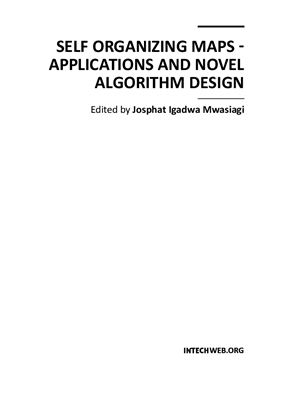Published by InTech. Janeza Trdine 9, 51000 Rijeka, Croatia. 2011.
ISBN 978-953-307-546-4, Hard cover, 702 p.
Первоисточник: http://www.intechopen.com.
Kohonen Self Organizing Maps (SOM) has found application in practical all fields, especially those which tend to handle high dimensional data. SOM can be used for the clustering of genes in the medical field, the study of multi-media and web based contents and in the transportation industry, just to name a few. Apart from the aforementioned areas this book also covers the study of complex data found in meteorological and remotely sensed images acquired using satellite sensing. Data management and envelopment analysis has also been covered. The application of SOM in mechanical and manufacturing engineering forms another important area of this book. The final section of this book, addresses the design and application of novel variants of SOM algorithms.
Contents:
Data interpretation and management
Information-theoretic approach to interpret inteal representations of self-organizing maps
Privacy-preserving clustering on distributed databases: a review and some contributions
A method for project member role assignment in open source software development using self-organizing maps
Data envelopment analysis modelling with self-organising maps and data envelopment analysis: a case study in educational evaluation
Self-organizing maps infusion with data envelopment analysis
The study of multi-media and Web-based contents
A speech recognition system for embedded applications using the SOM and TS-SOM networks
Combining SOMs and ontologies for effective web site mining
A study on facial expression recognition model using an adaptive leaing capability
Self-organization and aggregation of knowledge
Image search in a visual concept feature space with SOM-based clustering and modified inverted indexing
Mel-frequency cepstrum coefficients as higher order statistics representation to characterize speech signal for speaker identification system in noisy environment using hidden markov model
Improvements in the transportation industry
Ship’s hydroacoustics signatures classification using neural networks
Dynamic vehicle routing problem for medical emergency management
The study of meteorological, geomorphological and remotely acquired data
A review of self-organizing map applications in meteorology and oceanography
Using self organising maps in applied geomorphology
Land-cover classification using self-organizing maps clustered with spectral and spatial information
Applications of complex-valued self-organizing maps to ground penetrating radar imaging systems
Automated mapping of hydrographic systems from satellite imagery using self-organizing maps and principal curves
Application of SOM in medical and biological sciences
Computational approaches as a tool to study developmental biology in new world primates
Clustering genes, tissues, cells and bioactive chemicals by sphere SOM
Application of self-organizing maps in chemistry. the case of phenyl cations
Первоисточник: http://www.intechopen.com.
Kohonen Self Organizing Maps (SOM) has found application in practical all fields, especially those which tend to handle high dimensional data. SOM can be used for the clustering of genes in the medical field, the study of multi-media and web based contents and in the transportation industry, just to name a few. Apart from the aforementioned areas this book also covers the study of complex data found in meteorological and remotely sensed images acquired using satellite sensing. Data management and envelopment analysis has also been covered. The application of SOM in mechanical and manufacturing engineering forms another important area of this book. The final section of this book, addresses the design and application of novel variants of SOM algorithms.
Contents:
Data interpretation and management
Information-theoretic approach to interpret inteal representations of self-organizing maps
Privacy-preserving clustering on distributed databases: a review and some contributions
A method for project member role assignment in open source software development using self-organizing maps
Data envelopment analysis modelling with self-organising maps and data envelopment analysis: a case study in educational evaluation
Self-organizing maps infusion with data envelopment analysis
The study of multi-media and Web-based contents
A speech recognition system for embedded applications using the SOM and TS-SOM networks
Combining SOMs and ontologies for effective web site mining
A study on facial expression recognition model using an adaptive leaing capability
Self-organization and aggregation of knowledge
Image search in a visual concept feature space with SOM-based clustering and modified inverted indexing
Mel-frequency cepstrum coefficients as higher order statistics representation to characterize speech signal for speaker identification system in noisy environment using hidden markov model
Improvements in the transportation industry
Ship’s hydroacoustics signatures classification using neural networks
Dynamic vehicle routing problem for medical emergency management
The study of meteorological, geomorphological and remotely acquired data
A review of self-organizing map applications in meteorology and oceanography
Using self organising maps in applied geomorphology
Land-cover classification using self-organizing maps clustered with spectral and spatial information
Applications of complex-valued self-organizing maps to ground penetrating radar imaging systems
Automated mapping of hydrographic systems from satellite imagery using self-organizing maps and principal curves
Application of SOM in medical and biological sciences
Computational approaches as a tool to study developmental biology in new world primates
Clustering genes, tissues, cells and bioactive chemicals by sphere SOM
Application of self-organizing maps in chemistry. the case of phenyl cations

